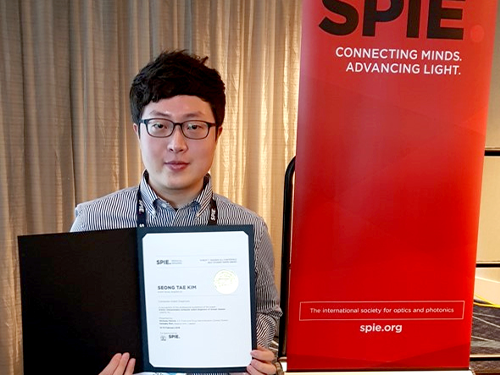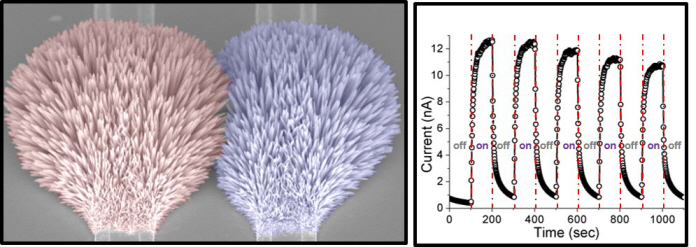SPIE
-
 Professor YongKeun Park Wins the 2018 Fumio Okano Award
(Professor Park)
Professor YongKeun Park from the Department of Physics won the 2018 Fumio Okano Award in recognition of his contributions to 3D display technology development during the annual conference of the International Society for Optics and Photonics (SPIE) held last month in Orlando, Florida in the US.
The Fumio Okano Best 3D Paper Prize is presented annually in memory of Dr. Fumio Okano, a pioneer and innovator of 3D displays who passed away in 2013, for his contributions to the field of 3D TVs and displays. The award is sponsored by NHK-ES.
Professor Park and his team are developing novel technology for measuring and visualizing 3D images by applying random light scattering. He has published numerous papers on 3D holographic camera technology and 3000x enhanced performance of 3D holographic displays in renowned international journals such as Nature Photonics, Nature Communications, and Science Advances. His technology has drawn international attention from renowned media outlets including Newsweek and Forbes.
He has established two startups to commercialize his technology. Tomocube specializes in 3D imaging microscopes using holotomographic technology and the company exports their products to several countries including the US and Japan. The.Wave.Talk is exploring technology for examining pre-existing bacteria anywhere and anytime.
Professor Park’s innovations have already been recognized in and out of KAIST. In February, he was selected as the KAISTian of the Year for his outstanding research, commercialization, and startups. He was also decorated with the National Science Award in April by the Ministry of Science and ICT and the Hong Jin-Ki Innovation Award later in May by the Yumin Cultural Foundation.
Professor Park said, “3D holography is emerging as a significant technology with growing potential and positive impacts on our daily lives. However, the current technology lags far behind the levels displayed in SF movies. We will do our utmost to reach this level with more commercialization."
2018.05.31 View 12731
Professor YongKeun Park Wins the 2018 Fumio Okano Award
(Professor Park)
Professor YongKeun Park from the Department of Physics won the 2018 Fumio Okano Award in recognition of his contributions to 3D display technology development during the annual conference of the International Society for Optics and Photonics (SPIE) held last month in Orlando, Florida in the US.
The Fumio Okano Best 3D Paper Prize is presented annually in memory of Dr. Fumio Okano, a pioneer and innovator of 3D displays who passed away in 2013, for his contributions to the field of 3D TVs and displays. The award is sponsored by NHK-ES.
Professor Park and his team are developing novel technology for measuring and visualizing 3D images by applying random light scattering. He has published numerous papers on 3D holographic camera technology and 3000x enhanced performance of 3D holographic displays in renowned international journals such as Nature Photonics, Nature Communications, and Science Advances. His technology has drawn international attention from renowned media outlets including Newsweek and Forbes.
He has established two startups to commercialize his technology. Tomocube specializes in 3D imaging microscopes using holotomographic technology and the company exports their products to several countries including the US and Japan. The.Wave.Talk is exploring technology for examining pre-existing bacteria anywhere and anytime.
Professor Park’s innovations have already been recognized in and out of KAIST. In February, he was selected as the KAISTian of the Year for his outstanding research, commercialization, and startups. He was also decorated with the National Science Award in April by the Ministry of Science and ICT and the Hong Jin-Ki Innovation Award later in May by the Yumin Cultural Foundation.
Professor Park said, “3D holography is emerging as a significant technology with growing potential and positive impacts on our daily lives. However, the current technology lags far behind the levels displayed in SF movies. We will do our utmost to reach this level with more commercialization."
2018.05.31 View 12731 -
 Seong-Tae Kim Wins Robert-Wagner All-Conference Best Paper Award
(Ph.D. candidate Seong-Tae Kim)
Ph.D. candidate Seong-Tae Kim from the School of Electrical Engineering won the Robert Wagner All-Conference Best Student Paper Award during the 2018 International Society for Optics and Photonics (SPIE) Medical Imaging Conference, which was held in Houston last month.
Kim, supervised by Professor Yong Man Ro, received the award for his paper in the category of computer-aided diagnosis. His paper, titled “ICADx: Interpretable Computer-Aided Diagnosis of Breast Masses”, was selected as the best paper out of 900 submissions. The conference selects the best paper in nine different categories. His research provides new insights on diagnostic technology to detect breast cancer powered by deep learning.
2018.03.15 View 12285
Seong-Tae Kim Wins Robert-Wagner All-Conference Best Paper Award
(Ph.D. candidate Seong-Tae Kim)
Ph.D. candidate Seong-Tae Kim from the School of Electrical Engineering won the Robert Wagner All-Conference Best Student Paper Award during the 2018 International Society for Optics and Photonics (SPIE) Medical Imaging Conference, which was held in Houston last month.
Kim, supervised by Professor Yong Man Ro, received the award for his paper in the category of computer-aided diagnosis. His paper, titled “ICADx: Interpretable Computer-Aided Diagnosis of Breast Masses”, was selected as the best paper out of 900 submissions. The conference selects the best paper in nine different categories. His research provides new insights on diagnostic technology to detect breast cancer powered by deep learning.
2018.03.15 View 12285 -
 SPIE (The International Society for Optics and Photonics): Scattering Super-lens
The International Society for Optics and Photonics (SPIE), dedicated to advancing an interdisciplinary approach to the science and application of light, published online a short paper authored by a KAIST research team, Dr. Jung-Hoon Park and Professor YongKeun Park of Physics, introducing a new optical technology to observe sub-wavelength light by exploiting multiple light scattering in complex media.
For the article, please go to the link below:
SPIE: Nanotechnology
May 7th, 2014
"Scattering superlens" by Jung-Hoon Park and YongKeun Park
http://spie.org/x108298.xml
2014.05.14 View 8269
SPIE (The International Society for Optics and Photonics): Scattering Super-lens
The International Society for Optics and Photonics (SPIE), dedicated to advancing an interdisciplinary approach to the science and application of light, published online a short paper authored by a KAIST research team, Dr. Jung-Hoon Park and Professor YongKeun Park of Physics, introducing a new optical technology to observe sub-wavelength light by exploiting multiple light scattering in complex media.
For the article, please go to the link below:
SPIE: Nanotechnology
May 7th, 2014
"Scattering superlens" by Jung-Hoon Park and YongKeun Park
http://spie.org/x108298.xml
2014.05.14 View 8269 -
 High Speed Nanomanufacturing Process Developed using Laser
Dr. Yeo Jun Yeop from KAIST’s Department of Mechanical Engineering, in a joint research project with Prof. Seung Hwan Ko, has developed a technology that speeds up the nanomanufacturing process by using lasers. Their research is published in the frontispiece of Advanced Functional Materials (July 9th issue).
Fig. The frontispiece of Advanced Functional Materials(July 9th issue)
The research group put a nanomaterial precursor on the board, illuminated it with a continuous-wave laser in the green wavelength range, and succeeded in synthesizing a nanowire at the point they wanted for the first time in the world.
Currently nanomaterials are difficult to mass produce and commercialize due to their complex and costly manufacturing processes which also use toxic gases. However, their new technology simplified the process and so reduced the manufacturing time from some hours to five minutes (1/10th times reduced).
Furthermore, this technology will apply regardless of the type of the board. Such nanometerials can be synthesized at any point on a flexible plastic board or even in three dimensional structures by illuminating them with a simple laser. Academics and industries expect mass production and commercialization of nanomaterials in near future.
Dr. Yeo said he intends to research further to promote early commercialization of multifunctional electronic devices by combining various nanomaterials
This research is sponsored by the National Research Foundation of Korea, the Ministry of Trade, Industry and Energy and KAIST EEWS
Fig. A nanomaterial synthesized after illuminated by lasers
Fig. A nanomaterial synthesized on a three dimensional structure using the developed technology
Fig. Functional electron device manufactured by using the synthesized nanomaterials
2013.08.02 View 10133
High Speed Nanomanufacturing Process Developed using Laser
Dr. Yeo Jun Yeop from KAIST’s Department of Mechanical Engineering, in a joint research project with Prof. Seung Hwan Ko, has developed a technology that speeds up the nanomanufacturing process by using lasers. Their research is published in the frontispiece of Advanced Functional Materials (July 9th issue).
Fig. The frontispiece of Advanced Functional Materials(July 9th issue)
The research group put a nanomaterial precursor on the board, illuminated it with a continuous-wave laser in the green wavelength range, and succeeded in synthesizing a nanowire at the point they wanted for the first time in the world.
Currently nanomaterials are difficult to mass produce and commercialize due to their complex and costly manufacturing processes which also use toxic gases. However, their new technology simplified the process and so reduced the manufacturing time from some hours to five minutes (1/10th times reduced).
Furthermore, this technology will apply regardless of the type of the board. Such nanometerials can be synthesized at any point on a flexible plastic board or even in three dimensional structures by illuminating them with a simple laser. Academics and industries expect mass production and commercialization of nanomaterials in near future.
Dr. Yeo said he intends to research further to promote early commercialization of multifunctional electronic devices by combining various nanomaterials
This research is sponsored by the National Research Foundation of Korea, the Ministry of Trade, Industry and Energy and KAIST EEWS
Fig. A nanomaterial synthesized after illuminated by lasers
Fig. A nanomaterial synthesized on a three dimensional structure using the developed technology
Fig. Functional electron device manufactured by using the synthesized nanomaterials
2013.08.02 View 10133